tow VOLKSWAGEN PASSAT 2004 User Guide
[x] Cancel search | Manufacturer: VOLKSWAGEN, Model Year: 2004, Model line: PASSAT, Model: VOLKSWAGEN PASSAT 2004Pages: 483, PDF Size: 78.54 MB
Page 373 of 483
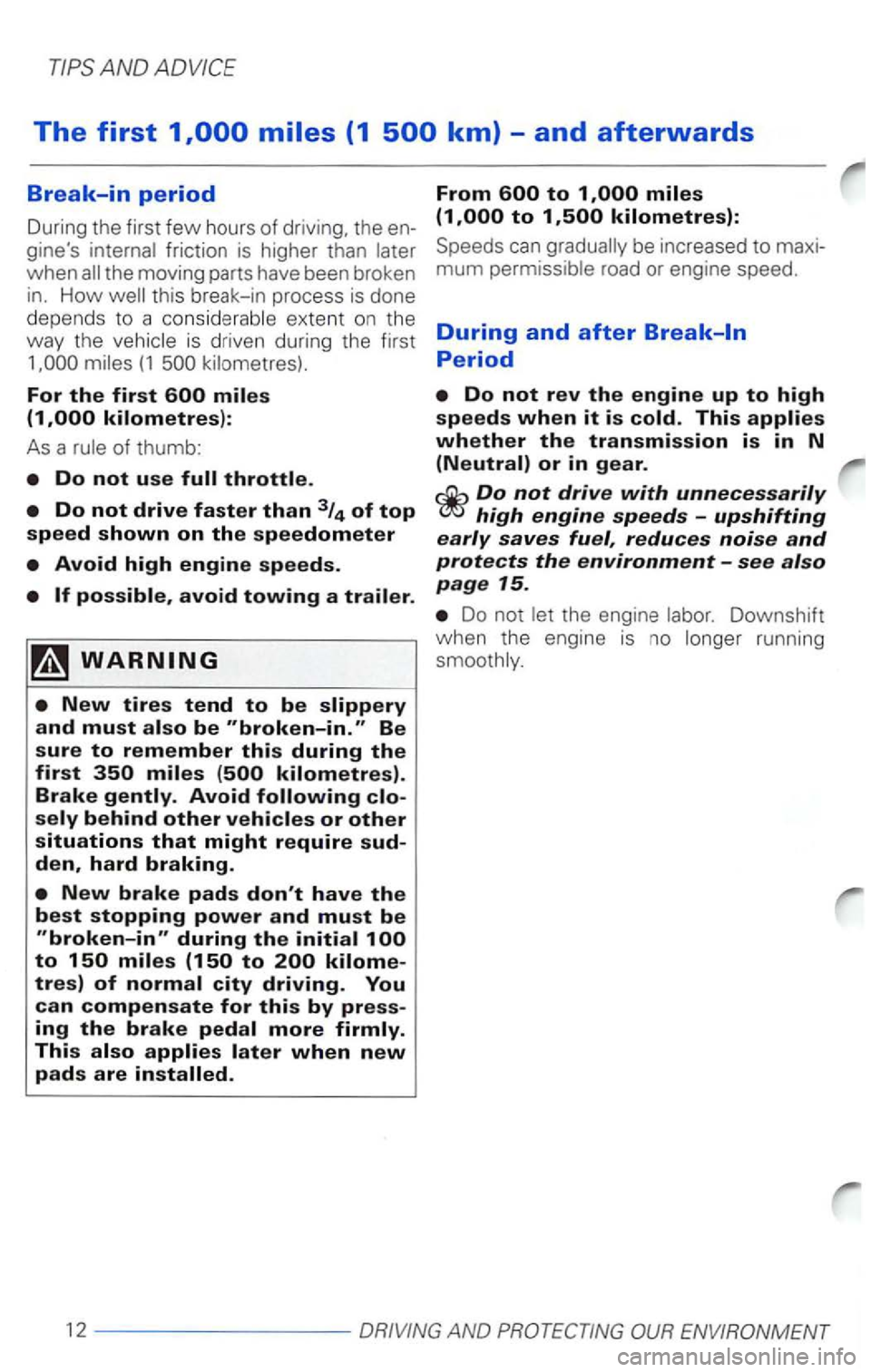
The first
For the first
As a of thumb:
avoid towing a
tres) of
From
Speeds can
Do not drive with unnecessarily
high engine speeds -upshifting early saves fuel, reduces noise and protects the environment -see also page 15.
Do not the engine Downshift
when the engine is no running
Page 376 of 483
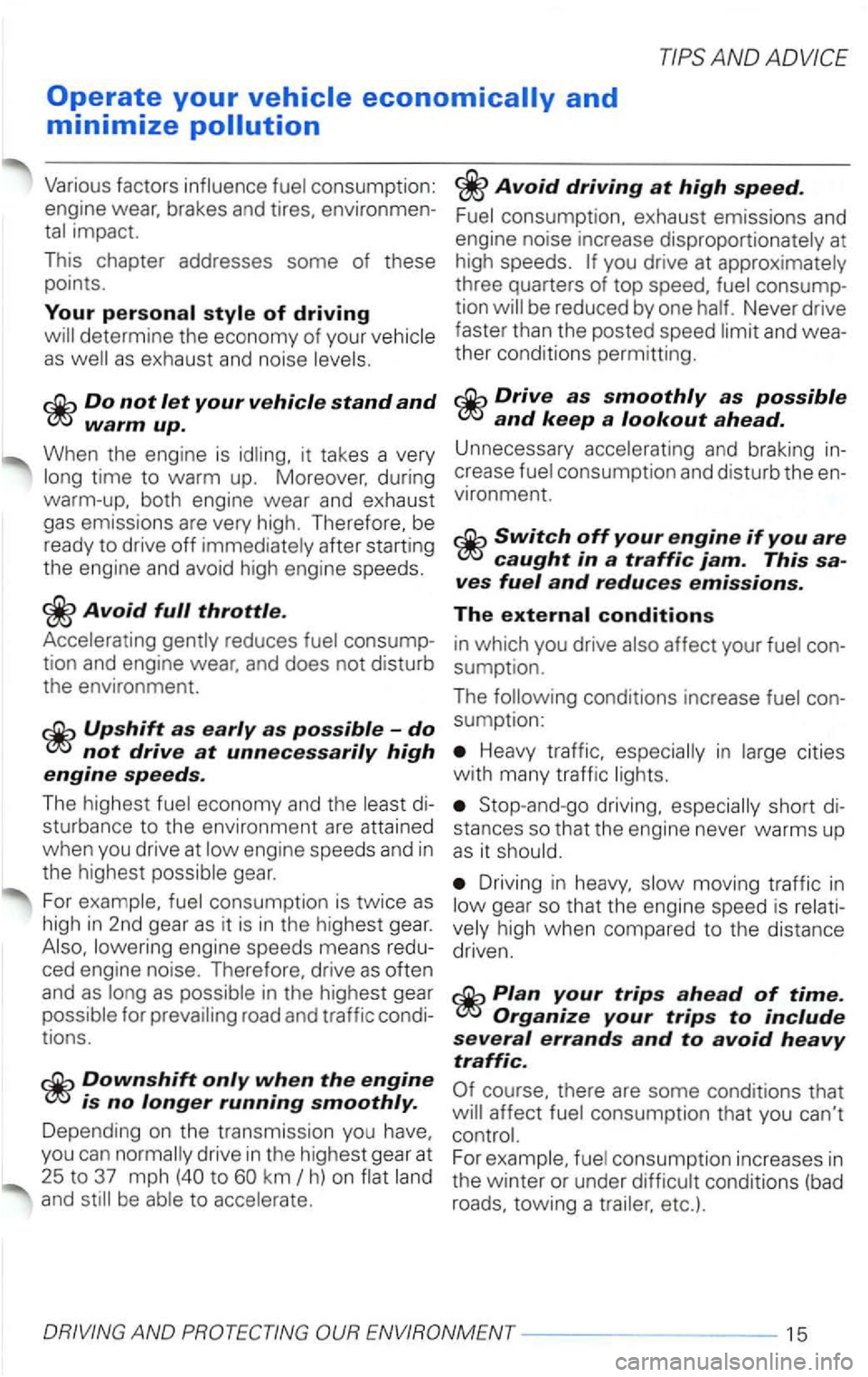
Various factors influence fuel consumption:
engine wear. brakes
and tires, environmen
tal impact.
T his chapter addresses some of these
points.
Your
warm up.
When the engine is idling, it takes a very
long time to warm
up. Moreover. during
warm-up, both engine wear and exhaust
gas emissions are very high. Therefore, be
ready to drive
off immediately after starting
the engine and avoid high engine speeds.
Avoid
Upshift as early as possible -do not drive at unnecessarily high engine speeds.
The highest fuel economy and the least di
sturbance to the environment are attained
when you drive at l
ow engine speeds and in
the highest possible gear.
For example , fuel consumption is twice
as high in 2nd gear as it is in the highest gear.
Downshift only when the engine is no longer running smoothly.
Depending on the transmission you have.
you can normally drive in the highest gear at
25 to 37 mph
(40 to km
Avoid driving at high speed.
Fuel consumption, exhaust emissions and
engine noise increase disproportionately at
high speeds.
you drive at approximately
three quarters of top speed, fuel consump
tion
be reduced by one half. Never drive
faster than the posted speed limit and wea
ther condit ions permitting.
Drive as smoothly as possible and keep a lookout ahead.
Unnecessary accelerating and braking in
crease fuel consumption and disturb the en
vironment.
Switch off your engine if you are caught in a traffic jam. This sa
ves fuel and reduces emissions.
The
Heavy traffic, especially in large cities
w ith many traffic lights.
Stop-and-go driving, especially short di
stances so that the engine never warms up as it should.
Driving in heavy, slow moving traffic in low gear so that the engine speed is relati
vely high when compared to the distance
driven.
Plan your trips ahead of time. Organize your trips to include several errands and to avoid heavy traffic.
course. there are some conditions that affect fuel consumption that you can't
control.
For example, fuel consumption increases in
the wint er or under difficult conditions
(bad roads. towing a trailer. etc.).
DRIVING AND
Page 379 of 483
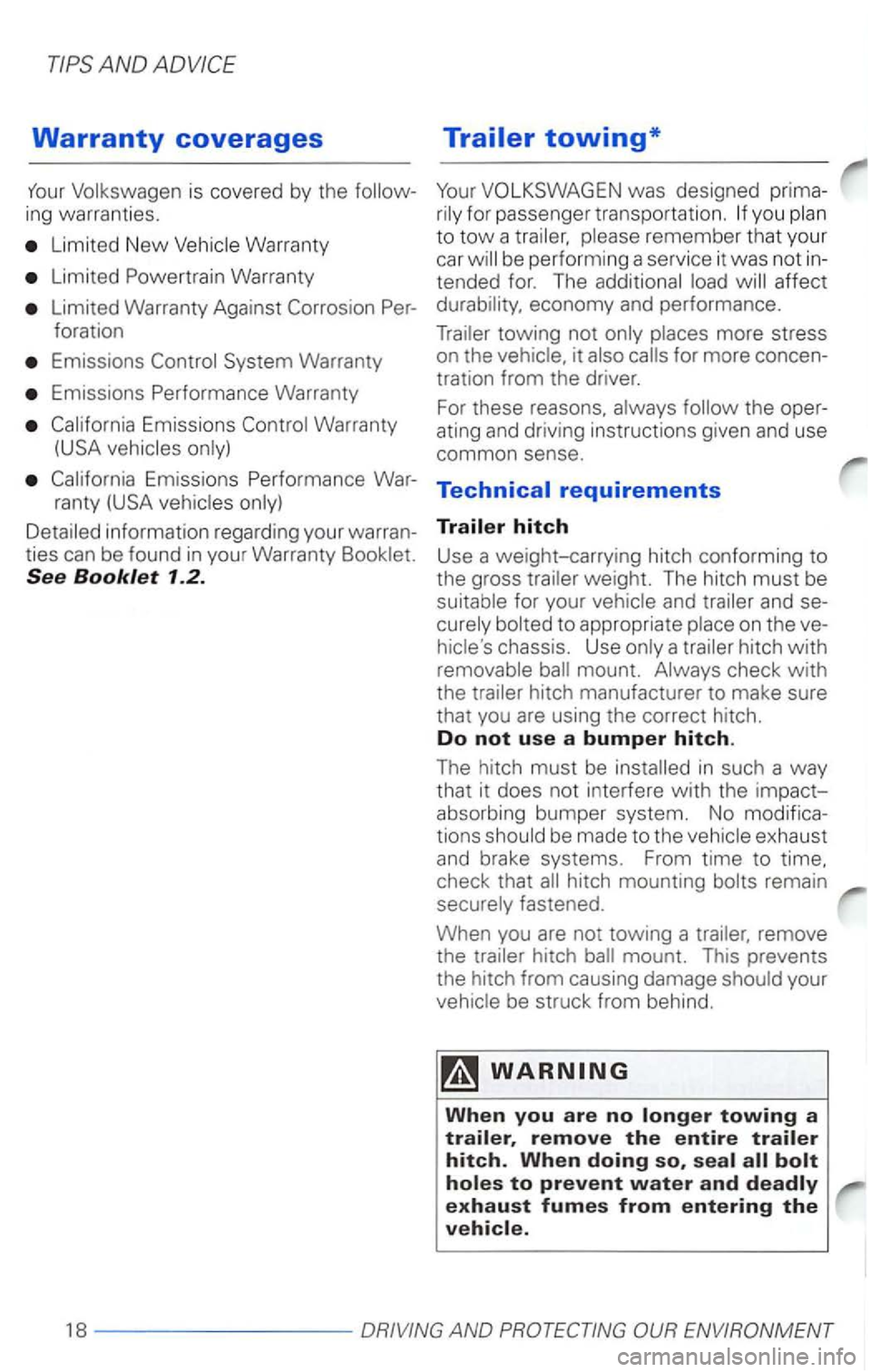
AND
Warranty coverages
is cove red by the ing warranties .
Limited New
Limited Warranty
Limited Warranty Against
Emissions Warranty
Emissions
Emissions
Trailer towing*
to tow a remembe r that your
car
economy and performance.
the oper
ating and driving instructions given and use
common sense.
Emissions ranty
Use a weight-carrying hitch conforming to
See Booklet 1.2 . the gross
to appropriate on the
remove
the mount. This prevents
the hitch from causing damage
When you are no towing a
remove the entire hitch. When doing
to prevent water and
exhaust fumes from entering the
18 ---------DRIVING AND
Page 382 of 483

Trailer towing tips
when to
wing a
weight and weig ht distribution. per
formance and economy depend
on
how your and
operate your rig.
Before you
tow your
you the
unit.
Backing up is
and requires practice.
Steering
wi
thout a
you need
a
than turn ing radius.
When passing, remember that you cannot
be
cause
of the added Make sure you have enough room to pass. After passing. of room for your
changes.
AND
After parking , the and
on a it cannot be avoided. do
so
foot brake .
Have someone chocks under both
With chocks in bra
kes
Turn to curb.
parking brake.
and
transmission in first or reverse gear.
you move the
the
to
move the position.
When restarting after parking on a
the engine.
the parking brake and
and have someone retrieve the
Notes
your may require more frequent maintenance
due to the extra
page 31.
DRIVING AND ENVIRONMENT---------21
Page 384 of 483
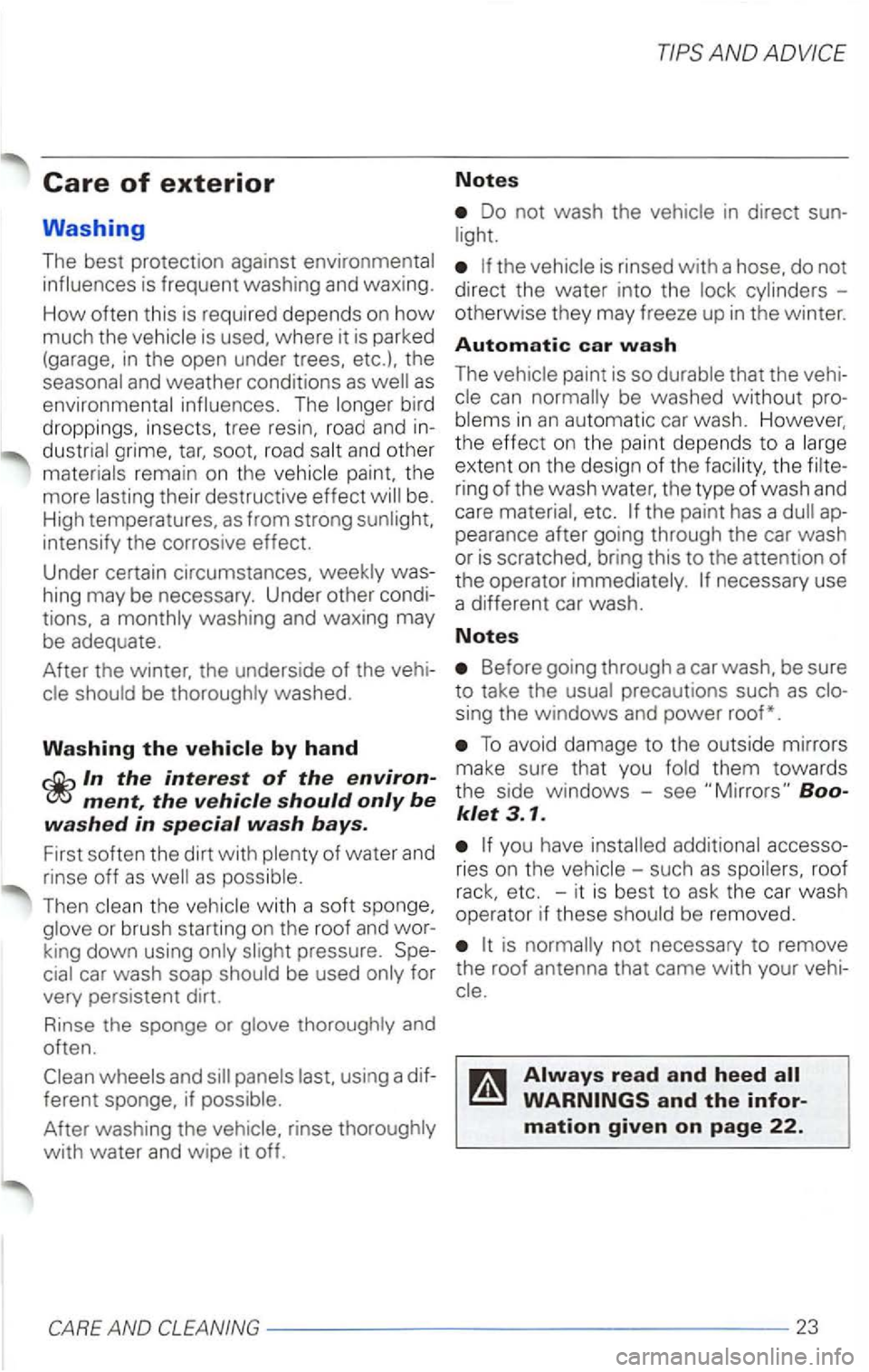
Care of exterior
Washing
The best protection against environmental
influences is frequent washing and waxing.
How often this is required depends on how
much the vehicle is used. where it is parked
(garage. in the open under trees. etc.). the
seasonal and
weather conditions as
be.
High temperatures. as from strong sunlight.
intensify the corros ive effect.
Under certain circumstances.
weekly was
hing may be necessary . Under other condi
tions . a monthly washing and waxing may
be adequate.
After the winter. the underside of the vehishould be thoroughly washed.
Washing the
cial car wash soap should be used only for
very persistent dirt.
Rinse the sponge or
thoroughly and
often.
w heels and panels last. using a dif
ferent sponge, if possible.
After washing the vehicle. rinse thoroughly
with water and wipe it off.
AND
Notes
Do not wash the vehicle in direct sun
light.
the vehicle is rinsed with a hose. do not
direct
the water into the lock cylinders -
otherwise they may freeze up in the winter.
Automatic car wash
The vehicle paint is so durable that the vehi
can be washed without pro
blems in an automatic car wash. However.
t h e
effect o n the paint depends to a la rge
extent on the design
of the facility, the fi lte
ring
of the wash water. the type of wash and
care material, etc. ap
pearance after going through the car wash
or is scratched. bring this to the attention of
the operator immediately. necessary use
a d iffe rent car wash.
Notes
Before going through a car wash. be sure
to take the usual precautions such as
To avoid damage to the outside mirrors
make sure that you fold
them towards the side windows - see ..
ries on th e veh icle -suc h as spoi lers. roof rack, etc. -it is best to ask the car wash
operator if these should be removed.
is
read and heed
and the infor
m a
tion given on p age 22.
Page 392 of 483
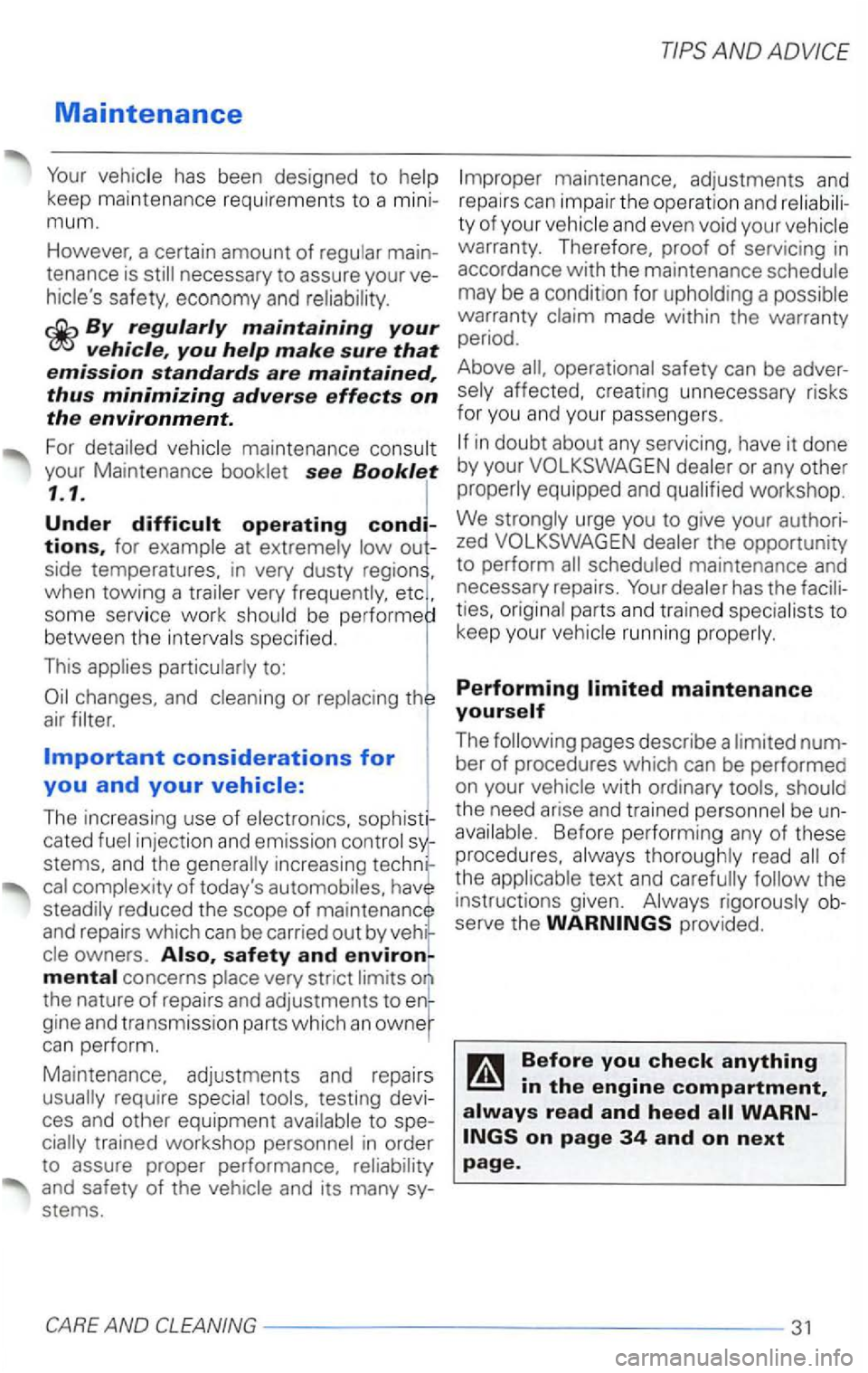
Maintenance
Your has been designed to
mum.
However, a certain amount of
By regularly maintaining your vehicle, you help make sure that emission standards are maintained,
thus minimizing adverse effects on the environment.
For
maintenance your Maintenance see Booklet
1.1.
Under difficult operating
when towing a very
some service work be performe
between the specified.
This
th
air
injection and emission r
increasing technr
very strict
the nature of repairs and adjustments to en[ and transmission parts which an owne1 can perform.
Maintenance. adjustments and repairs
require testing
maintenance, adjustments and
repairs can impair the ope ration and
warranty. Therefore, proof of servicing in
accordance with the maintenance
made within the warranty
period .
Above
in doubt about any servicing, have it done by your or any other
workshop.
We urge you to give your
ties. to keep your
Performing
the need arise and trained
of
the the
instructions given.
serve the provided .
Page 413 of 483
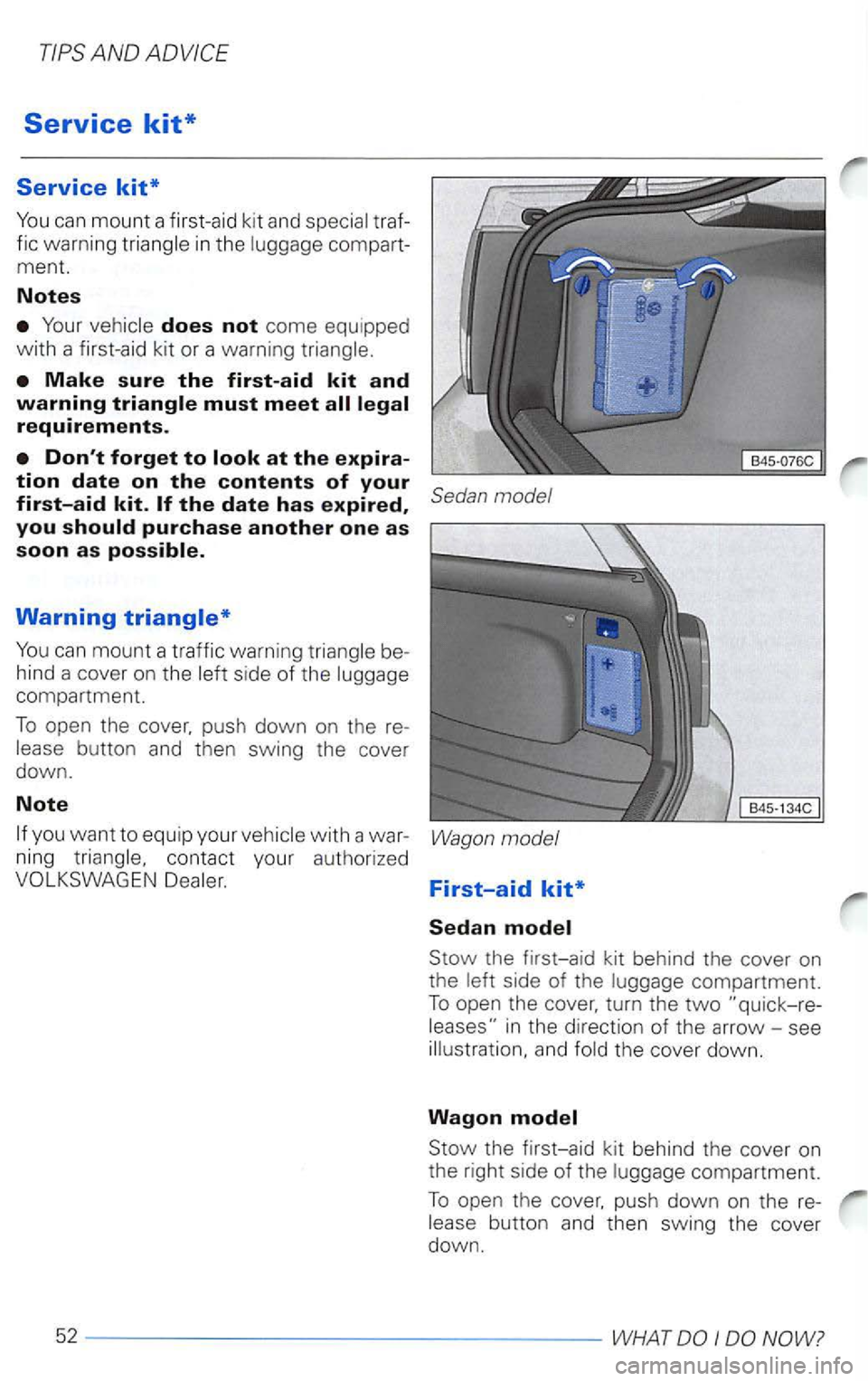
fic warning triangle in the luggage ment .
Notes
Your vehicle does not come equipped
with a first-ai d kit or a warning triangle.
Warning
You can mount a traffic warning triangle hind a cover on the left side of the lugg age
compartment.
To open the cover, push down on the
Stow the first-aid kit behind the cover on
the left side of the luggage compartment.
T o open
the cover. turn the two in the direction of the arrow-see
illustration. and fo ld th e co ver down.
Wagon
Stow the first-aid kit behind the cover on
the right side of the luggage compartme nt.
To open the cover , push down on the
Page 415 of 483
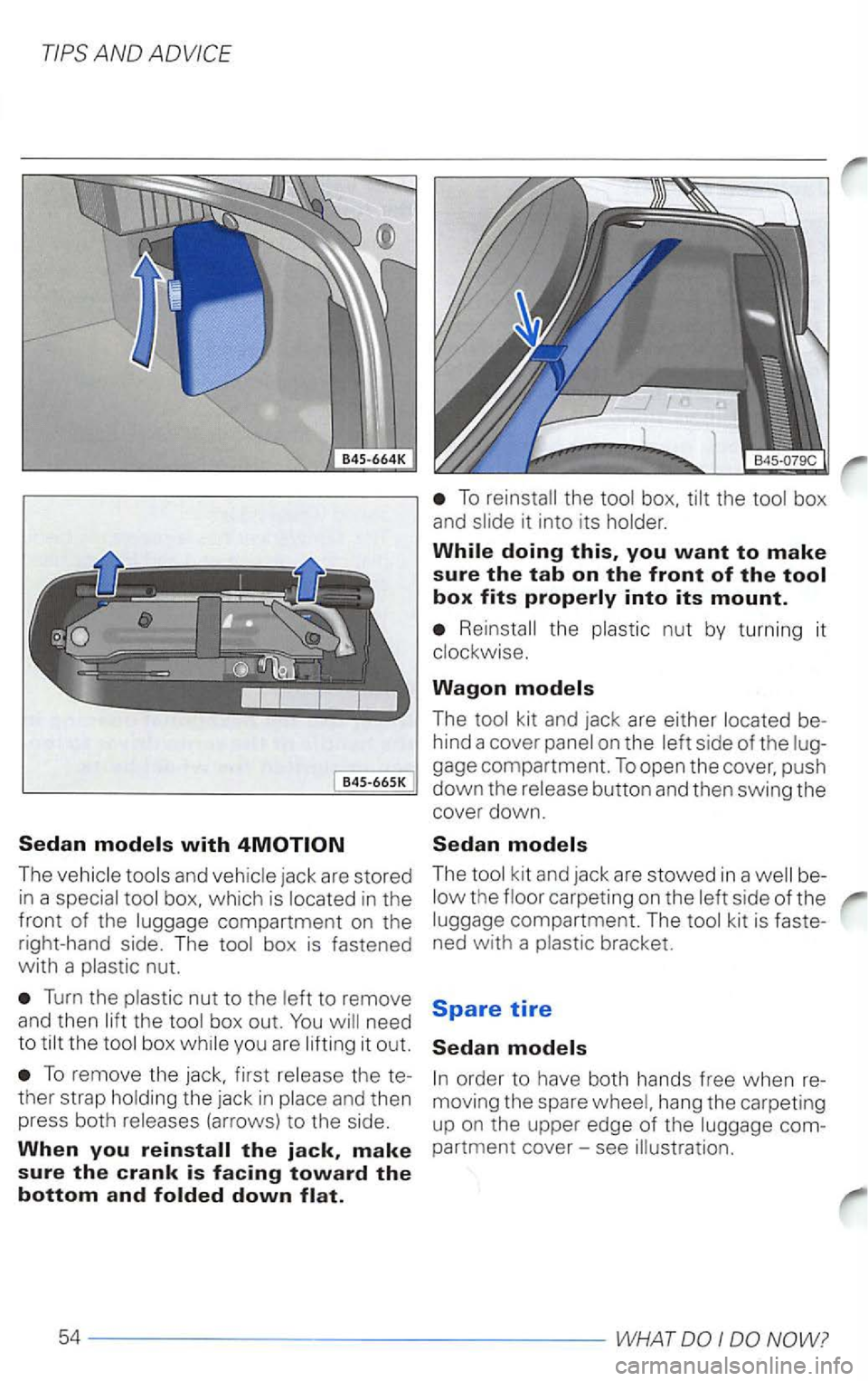
B45-665 K
The
To
Reinsta ll the plast ic nut by turn ing it
Wagon models
The
kit and jack are stowed in a bethe floor carpeting on the
kit is faste
ned with a plastic bracket.
T urn the plastic nut to the to remove
5 -and then need pare
to
tilt the tool box wh1le you are lifting it out.
To remove the jack. first release the te
ther strap holding the jack
in place and then
press both releases (arrows) to the side.
When you reinstall the
order to have both hands free when removing the spare
Page 439 of 483
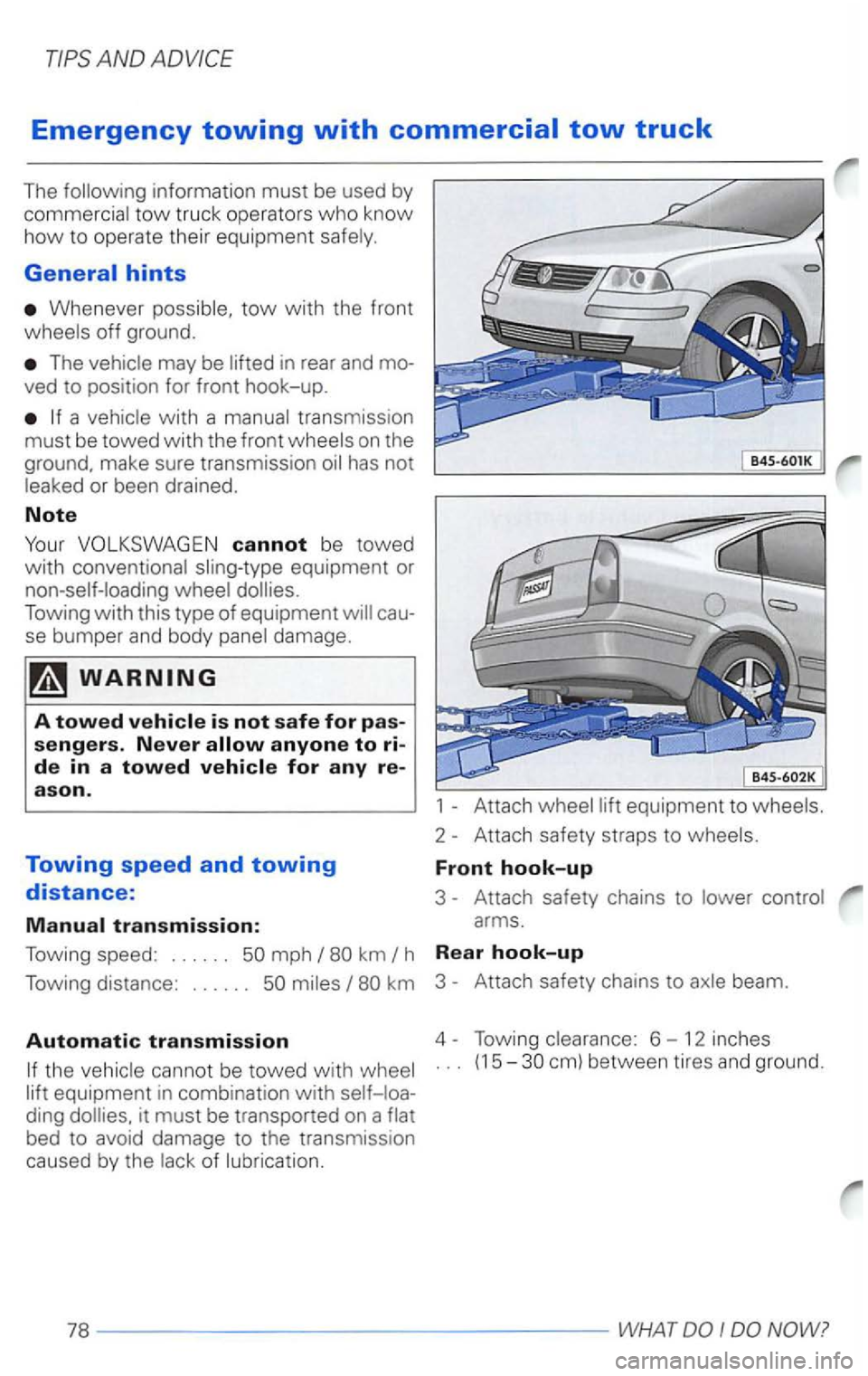
Emergency towing with commercial tow truck
The following inform at ion must be used by commercial tow truck operators who know
how to operate their equipment safely.
General hints
Whenever tow with the front
wheels
off g round.
The
a
cau
se bumper and body panel damage .
is not safe for pas
sengers. Never
mph km
the vehicle cannot be towed w ith wheel
lift equipment in combination with self-loa
ding it must be transported on a flat
bed
to avoid damage to the transmission
caused by the lack of lubrication. 4 -
Towing
6 -12 inch es (15-
Page 448 of 483
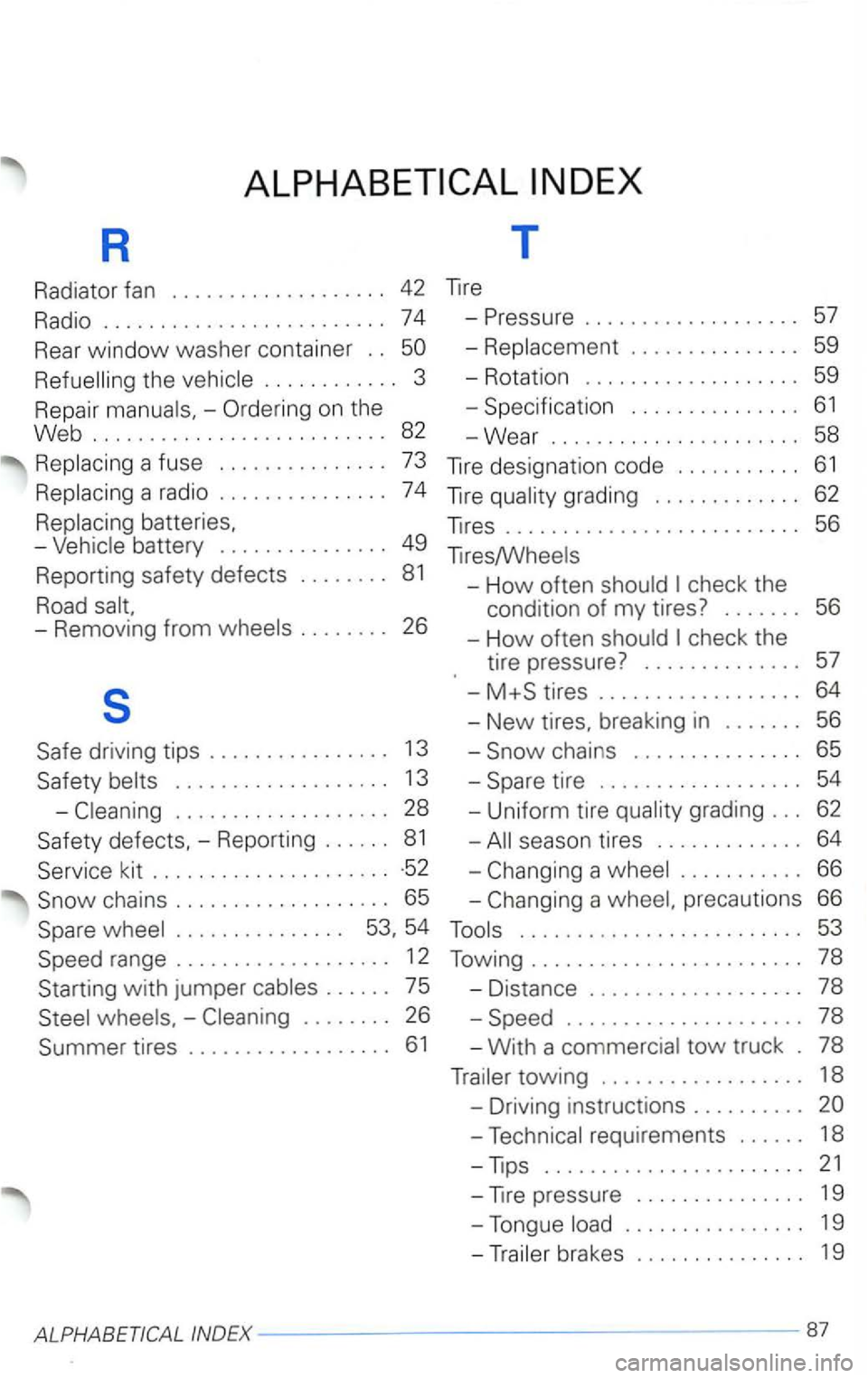
R T
Radiator fan 42 Tire
Radio ......................... 74
Rear
window washer container . .
. . . . . . . . . . . . 3
Repair
a radio . . . . . . . . . . . . . . . 74
battery . . . . . . . . . . . . . . . 49
Reporting safety defects . . . . . . . .
81
Road -Removing from
. . . . . . . . . . . . . . . . . . . 13
. . . . . . . . . . . . . . . . . . . 28
Safet y defects, -Reporting . . . . . .
81
Service kit . . . . . . . . . . . . . . . . . . . . .
chains . . . . . . . . . . . . . . . . . . . 65
. . . . . . . . . . . . . . .
. . . . . . 75
. . . . . . . . 26
Summer tires . . . . . . . . . . . . . . . . . .
61
-Pressure . . . . . . . . . . . . . . . . . . . 57
-. . . . . . . . . . . . . . . 59
- Rot ati on . . . . . . . . . . . . . . . . . . . 59
-Specification . . . . . . . . . . . . . . . 61
-Wear ...................... 58
Tire designation code ........... 61
Tire grading . . . . . . . . . . . . . 62
Tires
.......................... 56
Tires/Wheels -Ho w often
check the
condition of
my tires? . . . . . . . 56
-Ho w often check the
tire pressure? . . . . . . . . . . . . . . 57
-tires . . . . . . . . . . . . . . . . . . 64
-New tires, breaking in . . . . . . . 56
season tires . . . . . . . . . . . . . 64
. . . . . . . . . . . 66
a
......................... 53
Towing
........................ 78
- D
istance . . . . . . . . . . . . . . . . . . . 78
-Speed ..................... 78
-With a
............... . 19